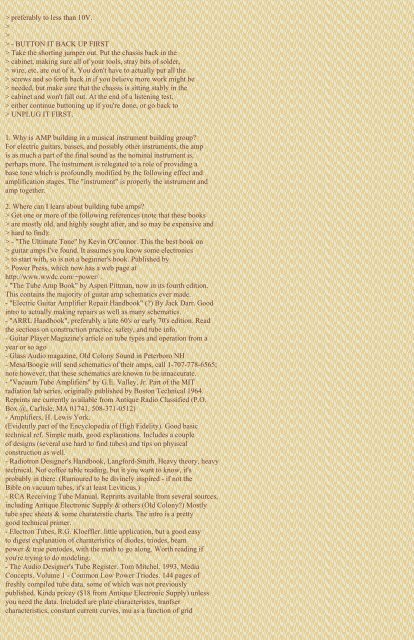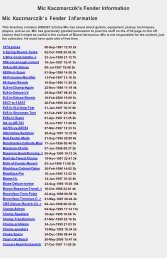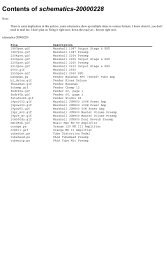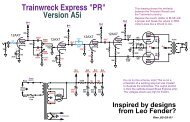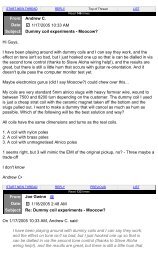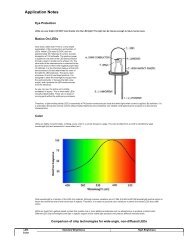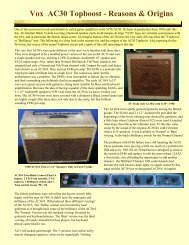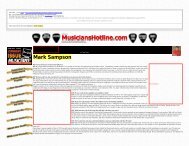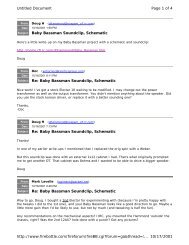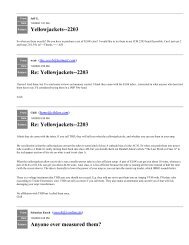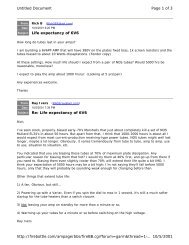Mic Kaczmarczik's TubeInformation - The Blue Guitar
Mic Kaczmarczik's TubeInformation - The Blue Guitar
Mic Kaczmarczik's TubeInformation - The Blue Guitar
You also want an ePaper? Increase the reach of your titles
YUMPU automatically turns print PDFs into web optimized ePapers that Google loves.
preferably to less than 10V.<br />
><br />
><br />
> - BUTTON IT BACK UP FIRST<br />
> Take the shorting jumper out. Put the chassis back in the<br />
> cabinet, making sure all of your tools, stray bits of solder,<br />
> wire, etc. are out of it. You don't have to actually put all the<br />
> screws and so forth back in if you believe more work might be<br />
> needed, but make sure that the chassis is sitting stably in the<br />
> cabinet and won't fall out. At the end of a listening test,<br />
> either continue buttoning up if you're done, or go back to<br />
> UNPLUG IT FIRST.<br />
1. Why is AMP building in a musical instrument building group?<br />
For electric guitars, basses, and possibly other instruments, the amp<br />
is as much a part of the final sound as the nominal instrument is,<br />
perhaps more. <strong>The</strong> instrument is relegated to a role of providing a<br />
base tone which is profoundly modified by the following effect and<br />
amplification stages. <strong>The</strong> "instrument" is properly the instrument and<br />
amp together.<br />
2. Where can I learn about building tube amps?<br />
> Get one or more of the following references (note that these books<br />
> are mostly old, and highly sought after, and so may be expensive and<br />
> hard to find):<br />
> - "<strong>The</strong> Ultimate Tone" by Kevin O'Connor. This the best book on<br />
> guitar amps I've found. It assumes you know some electronics<br />
> to start with, so is not a beginner's book. Published by<br />
> Power Press, which now has a web page at<br />
http://www.wwdc.com/~power/ .<br />
- "<strong>The</strong> Tube Amp Book" by Aspen Pittman, now in its fourth edition.<br />
This contains the majority of guitar amp schematics ever made.<br />
- "Electric <strong>Guitar</strong> Amplifier Repair Handbook" (?) By Jack Darr. Good<br />
intro to actually making repairs as well as many schematics.<br />
- "ARRL Handbook", preferably a late 60's or early 70's edition. Read<br />
the sections on construction practice, safety, and tube info.<br />
- <strong>Guitar</strong> Player Magazine's article on tube types and operation from a<br />
year or so ago<br />
- Glass Audio magazine, Old Colony Sound in Peterboro NH<br />
- Mesa/Boogie will send schematics of their amps, call 1-707-778-6565;<br />
note however, that these schematics are known to be innaccurate.<br />
- "Vacuum Tube Amplifiers" by G.E. Valley, Jr. Part of the MIT<br />
radiation lab series, originally published by Boston Technical 1964.<br />
Reprints are currently available from Antique Radio Classified (P.O.<br />
Box @, Carlisle, MA 01741, 508-371-0512)<br />
- Amplifiers, H. Lewis York.<br />
(Evidently part of the Encyclopedia of High Fidelity). Good basic<br />
technical ref. Simple math, good explanations. Includes a couple<br />
of designs (several use hard to find tubes) and tips on phyiscal<br />
construction as well.<br />
- Radiotron Designer's Handbook, Langford-Smith. Heavy theory, heavy<br />
technical. Not coffee table reading, but it you want to know, it's<br />
probably in there. (Rumoured to be divinely inspired - if not the<br />
Bible on vacuum tubes, it's at least Leviticus.)<br />
- RCA Receiving Tube Manual. Reprints available from several sources,<br />
including Antique Electronic Supply & others (Old Colony?) Mostly<br />
tube spec sheets & some charaterstic charts. <strong>The</strong> intro is a pretty<br />
good technical primer.<br />
- Electron Tubes, R.G. Kloeffler. little application, but a good easy<br />
to digest explanation of charateristics of diodes, triodes, beam<br />
power & true pentodes, with the math to go along. Worth reading if<br />
you're trying to do modeling.<br />
- <strong>The</strong> Audio Designer's Tube Register. Tom Mitchel. 1993, Media<br />
Concepts. Volume 1 - Common Low Power Triodes. 144 pages of<br />
freshly compiled tube data, some of which was not previously<br />
published. Kinda pricey ($18 from Antique Electronic Supply) unless<br />
you need the data. Included are plate characteristcs, tranfser<br />
characteristics, constant current curves, mu as a function of grid


